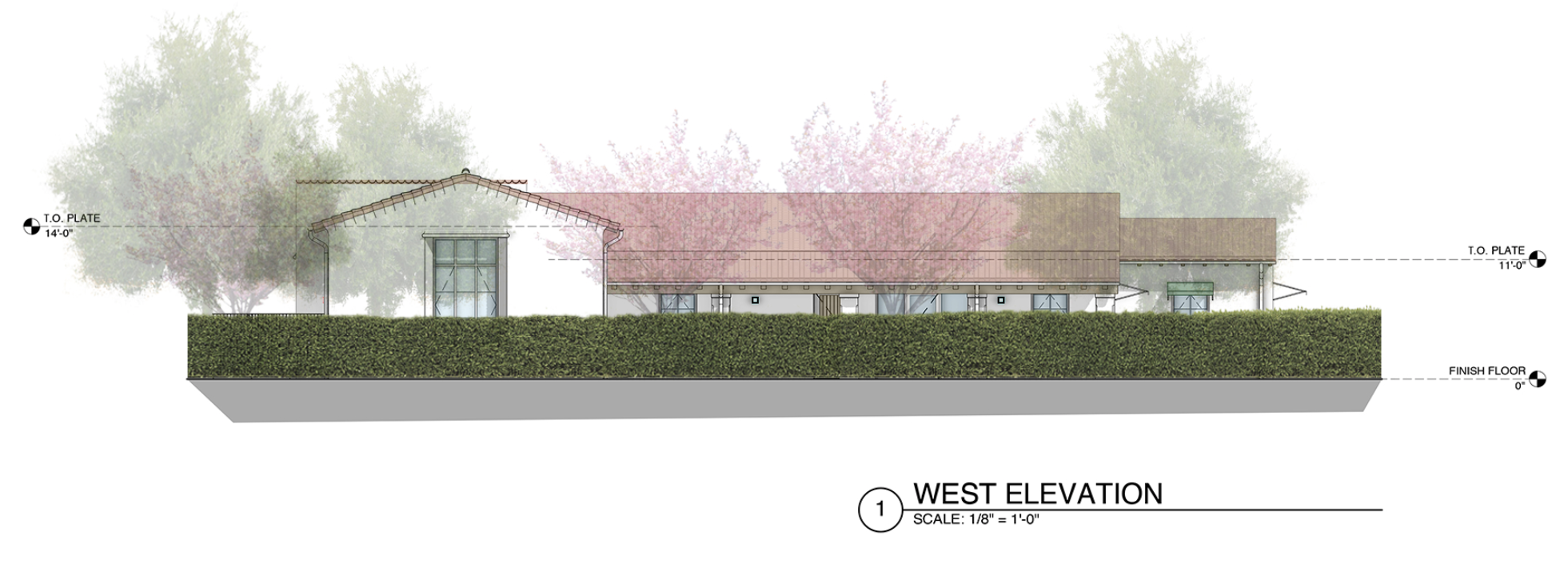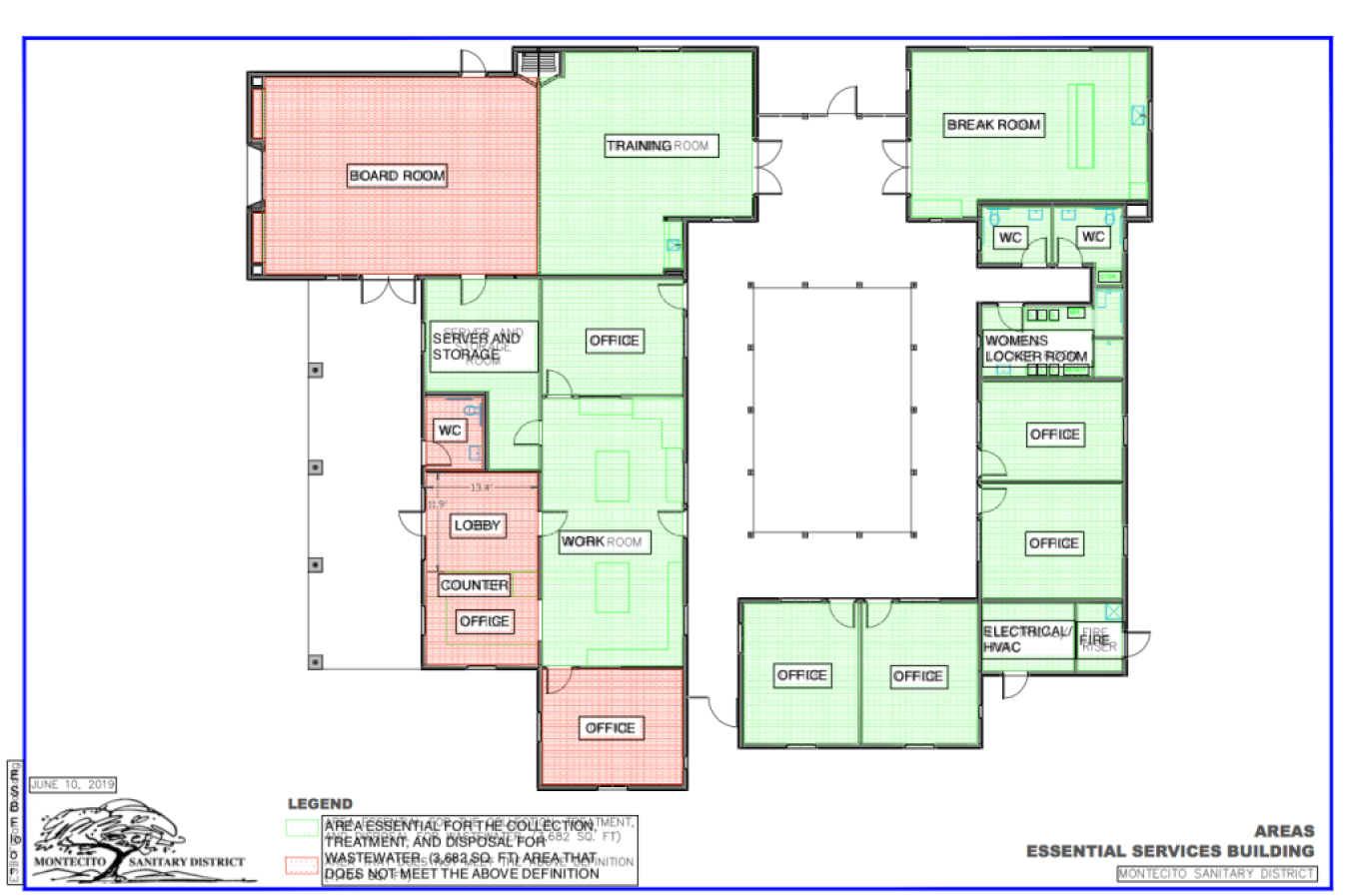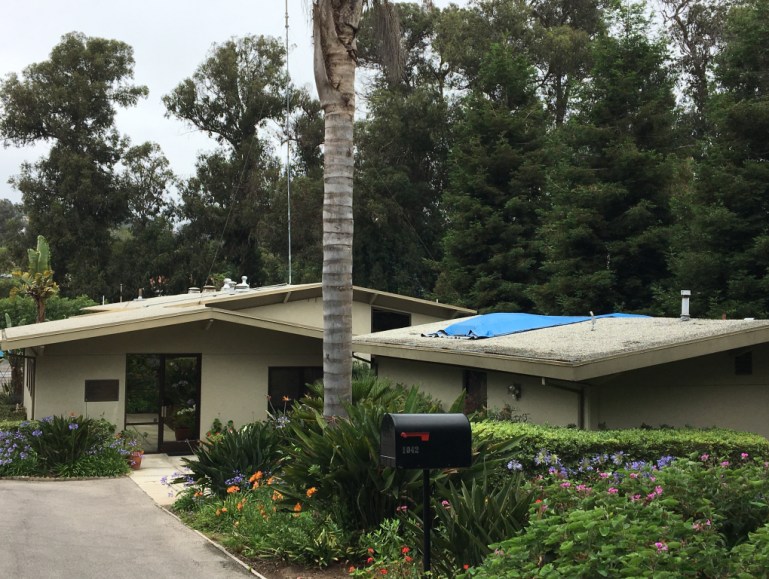No Truce in Montecito’s Water Wars
Opponents Take Aim at New Operations Building for Sanitary District

The plans for a new operations building at the Montecito Sanitary District — a project 15 years in the making — are suddenly in limbo, a potential casualty of Montecito’s divisive water wars.
The district board awarded $4.6 million in contracts for a 5,000-square-foot “essential services building” earlier this month on a 3-2 vote. The majority said it was well past time to replace the aging and substandard offices that were built decades ago behind the wastewater treatment plant at 1042 Monte Cristo Lane. Construction was set to begin in August along Channel Drive.
“These buildings have probably passed their life expectancy: I don’t think they were very well built,” Board President Tom Bollay, a Montecito architect, said on June 7 in the district’s boardroom, under a roof that was tarped against leaks. “We need to be thinking one hundred years out. Previous boards have discussed this every year at public hearings, and at some point, we have to move forward.”
The district has 17 employees: The board majority said a new operations building would improve their desk space, bathrooms, break rooms, showers, and training areas and bring working conditions into compliance with state and federal regulations. The building is vital to the district’s wastewater-treatment operations and exempt under state law from county permits and environmental review, the board said.
But opponents of the project cried foul, and, within days of the meeting, asked the county Planning and Development Department to intervene. Last week, a county building inspector visited the district to ensure that no construction was underway.
“We did some research, and our interpretation is that the building does require county permits,” Lisa Plowman, the department director, said, adding that she would meet with district officials in July to discuss the timing. Environmental review, if required, could delay the project by as much as six months, Plowman said.
Merger Mania
For now, the operations building is on hold. But perhaps the larger question is whether the sanitary district itself will survive as an independent agency.
During the election campaign last November, routine district wastewater operations that the state Regional Water Quality Board views as commendable were the subject of blistering attacks by the Committee for Montecito Water Security, a slate of three candidates for the five-member Montecito Water District board and two for the Sanitary District board.
Backed by $120,000 in donations from a group of wealthy residents, including a number of members of the exclusive Birnam Wood and Valley Club of Montecito golf courses on East Valley Road, the slate won. Now, some of the new boardmembers and their donors have ambitious plans for the sanitary district’s 5.6-acre property and its $7-million capital replacement fund.
First and foremost, they advocate for the consolidation, or merger, of Montecito’s sanitary and water districts.

“These things are in motion,” said Woody Barrett, a petroleum geologist who was recently elected to the sanitary district board, told his colleagues on June 7. “It’s too soon in the ballgame to commit to a new building.”
Besides, Barrett said the land for the building project might someday be needed for a desalination plant, if a deal for a share of Santa Barbara’s supply falls through. (An $80-million plan for a standalone plant has been shelved by the water district.)
Echoing one of the slate’s campaign promises, Barrett said the money for the new sanitary district building could be better spent helping some residents get off their septic systems and connect to the sewers.
“Why do we need this new building? It hasn’t been explained to me,” he said. “I really can’t see how it benefits the ratepayers.”
Jeff Kerns, who has served on the board for eight years, responded, “It’s going to have to be built someday. Do you wait until this one has fallen totally apart?”
“The building would still be useful if we combine in a community services district,” Kerns said.
But from the audience, Ed Martin, a Montecito attorney and a $500 donor to the November slate, said, “If you let the contract now, it will be impossible to consolidate.”
Bob Short, a retired real estate developer and “social member” of Birnam Wood who contributed $6,600 to the slate, also spoke in favor of deferring the building project. “The land and money can be better utilized for the future of recycling,” he said.
Bob Hazard, associate editor of the Montecito Journal, said the board should place on its agenda a potential merger with the water district to form one special district, saying it was “totally irresponsible” to “barrel ahead, not knowing what direction we’re going to go in the future.”
“There are active discussions about a community services district,” he said.
In recent years, Hazard has promoted district consolidation in the pages of the Journal as a first step toward cityhood for Montecito. Hazard is a resident and past president of Birnam Wood and a major contributor to the November slate, with $5,000 in donations.

Within days of the meeting, Short and Martin called county Planning and Development to request a review of the building project. And on June 19, Martin addressed the Montecito Planning Commission, calling for environmental review of the property to determine the “toxic site conditions before any construction for human occupancy were permitted.”
Judy Ishkanian, who lost her board seat to the slate in November, is watching what she calls “a full-court press against that building” with some consternation.
“Could it be a lot of loose talk?” said Ishkanian, who helped plan the project during 12 years on the board. “They’re picturing their own use for the land and the organization, and it’s not founded in realistic goals. They might deeply misunderstand what the role of independent special districts is, and how far you can stray from their dedicated public purpose.”
Weighing in on the dispute on Monday, county Supervisor Das Williams, who represents Montecito, said he hoped the water and sanitary districts would work together on a “substantive recycled water project” as their highest priority.
“If that happened, there might be less controversy over this building,” Williams said. “Recycled water is lower-energy usage and cheaper and more consistent than some of the other of Montecito’s options.”
Big Plans, Small Plans
The November election and the big money behind it have upended water politics in the affluent community of one-acre lots and large estates, where 90 percent of the water district’s annual supply is sprayed on lawns and gardens. The campaign came on the heels of the seventh year of a severe drought, in which residents faced stiff penalties for overwatering. A number of wells went dry, including two water district wells that supply Birnam Wood.
Today, the new water district board is putting the final touches on a proposed deal with the City of Santa Barbara, in which the city would expand its desalination plant and supply water to Montecito over 50 years, at a cost to Montecito of about $5 million per year. In addition, the board is looking into purifying Montecito’s wastewater to drinking-water standards on the sanitary district property, then injecting it into the groundwater basins. The estimated cost of that project is $32 million.
Meanwhile, the sanitary district has been laying the groundwork for a more modest plan – treating wastewater to non-potable standards for irrigation. It would be similar to what Santa Barbara and Goleta have been doing for 25 years, but on a smaller scale.
In the end, Kerns said, only 10 percent of the Montecito’s water is used indoors and can be recovered through the sewer system for recycling.
“It’s a relatively small amount, compared to the needs,” he said. “That seems to be lost in all of this.”
Under the sanitary district proposal, the lion’s share of Montecito’s recycled water supply would go through “purple pipes” to the district’s neighbors — the cemetery, music academy and the Biltmore resort, three of the biggest water users in the community. (The golf courses are four miles away and uphill from the sanitary district.)
The back-of-the-envelope cost estimate for the purple pipes project is between $4.5 and $5 million, district officials said.
“Intuitively, it would be as low-cost a project as there would be,” Kerns said, noting that the plan could not proceed without the water board’s approval. “It’s natural to consider it.”

In late August, the sanitary district plans to launch a pilot project on its property for recycling wastewater to non-potable standards. The recycled water will be used instead of drinking water to irrigate district landscaping and clean out the sewer lines.
The district has proposed testing the non-potable supply on the lawn at the cemetery, just across Channel Drive. At 10 a.m. on July 2, a committee of the sanitary and water districts will discuss the idea.
Mold and Dry Rot
Before this year, plans for the operations building had undergone 20 public hearings with no mention of any significant impacts to the environment, sanitary district officials said.
Diane Gabriel, the general manager, said that 70 percent of the new building would be used by workers who “touch wastewater every day” and need to log onto computers as part of their jobs. The present district offices have mold, dry rot, termites, and asbestos, and there is no air conditioning or heating, Gabriel said. They would be demolished when the new building is finished.
“We have to have a place where people who work outside can come in and cool off and get hydrated,” Gabriel said. “OSHA has strict rules about preventing heat illness.”
The district has never subsidized property owners who want to hook up to the sewers, she said, adding that the cost of extending sewer lines to 220 homes on septic systems in Montecito would be about $20 million.
As for the chemicals used in wastewater treatment, Gabriel said, they are fully contained above ground as required by law, and there has never been a leak or a spill on district property.
Finally, she said, the district has long set aside nearly an acre of land for whatever recycling project the water and sanitary districts agree to build.
“There’s plenty of room,” Gabriel said.
Melinda Burns is a freelance journalist in Santa Barbara.




You must be logged in to post a comment.